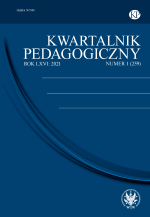Nierówności edukacyjne i szkolne segregacje czyli szkoła publiczna
wobec wyzwań spójności społecznej w lokalnym systemie edukacji
Educational inequalities and school segregation. Social cohesion
challenges faced by public schools in the local educational system
Author(s): Roman DolataSubject(s): Social Sciences, Education, Sociology
Published by: Wydawnictwa Uniwersytetu Warszawskiego
Keywords: educational inequality; school segregation; local educational policy; Ostrołęka Project
Summary/Abstract: Challenges that schools face in relation to social cohesion include the need to minimise theimpact of students’ social background on their educational career and ensuring that the publicschool is a place of contact between children from different social groups and class. Researchsupporting local policy in this area should therefore monitor the social status-baseddeterminants of students’ educational careers and other processes of intentional as well asspontaneous between school and between classroom segregation. The following facts werefound in the local educational system analysed. The measures of SES dimensions of students’family are significantly related to their school achievement. In Ostrołęka, this connection wasfound to be considerably stronger than the national average. However, which is certainly anoptimistic result, the financial resources of the students’ families, with other SES dimensionscontrolled, did not affect school achievement. Parents’ educational aspirations for theirchildren, on the other hand, are related to all aspects of socio-economic status. In this case,also the financial capacity of the students’ families is significantly related to the level of theseaspirations. Including students’ school grades along with the SES dimensions in the analysisof the determinants of educational aspirations shows that they determine aspirations to thesame degree as family status does. Sadly, there is no evidence that pre-school education helpslow SES students catch up with their peers with high SES families. This means that the keyto effectively support the development of children from educationally at-risk backgrounds isin the quality of preschool education and not just its universality. Schools in Ostrołęka differ in their social composition in terms of the parents’ education status and the financial capacityof their families, but the scale of these differences is not considerable. On the other hand,between classroom within school differentiation due to parents’ social status is in someschools much stronger than inter-school differences, which poses a serious problem.
Journal: Kwartalnik Pedagogiczny
- Issue Year: 259/2021
- Issue No: 1
- Page Range: 19-53
- Page Count: 35
- Language: Polish
- Content File-PDF

